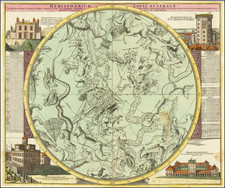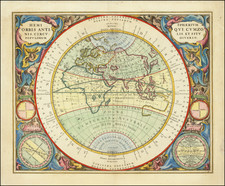An Excellent and Breathtaking Lithograph of the Milky Way. Made by the "Audubon of the Sky", Etienne Trouvelot.
This is a beautiful color lithograph of the Milky Way, by Etienne Trouvelot, relating his observations made over the course of the years 1874-1876. The chromolithograph was published as part of Trouvelot's Astronomical Drawings set of 15 plates by Charles Scribner's Sons in 1882.
The night sky is stunningly depicted in chromolithography, with the ghostly arms of the milky way running along the vertical center of the image. Bright and faint stars dot the background. In the foreground, a translucent ship sails along the horizon, nestled in clouds. The artistic qualities of the image are stunning.
Trouvelot describes the image in his work The Trouvelot Astronomical Drawings Manual as follows:
The course of the portion of the Galaxy represented in Plate XIII. is as follows: From Cassiopeia’s chair, three bright stars of which appear at the upper edge of the Plate, the Galaxy, forming two streams, descends south, passing partly through Lacerta on the left, and Cepheus on the right; at this last point it approaches nearest to the Polar Star, which is itself outside of the field of view. Then it enters Cygnus, where it becomes very complicated and bright, and where several large cloudy masses are seen terminating its left branch, which passes to the right, near the bright star Deneb, the leader of this constellation. Below Deneb, the Galaxy is apparently disconnected and separated from the northern part by a narrow, irregular dark gap. From this rupture, the Milky-way divides into two great streams, separated by an irregular dark rift. An immense branch extends to the right, which, after having formed an important luminous mass between the stars Gamma and Beta, continues its southward progress through parts of Lyra, Vulpecula, Hercules, Aquila and Ophiuchus, where it gradually terminates a few degrees south of the equator. The main stream on the left, after having formed a bright mass around Epsilon Cygni, passes through Vulpecula and then Aquila, where it crosses the equinoctial just below the star Eta, after having involved in its nebulosity the bright star Altair, the leader of Aquila. In the southern hemisphere the Galaxy becomes very complicated and forms a succession of very bright, irregular masses, the upper one being in Scutum Sobieskii, while the others are respectively situated in Sagittarius and in Scorpio; the last, just a little above our horizon, being always considerably dimmed by vapors. From Scutum Sobieskii, the Galaxy expands considerably on the right, and sends a branch into Scorpio, in which the fiery red star Antares is somewhat involved. In the upper left-hand corner of the Plate, at some distance from the Milky-way, is seen dimly the Nebula in Andromeda, which becomes so magnificent an object to telescopic view.
Rarity
Trouvelot's prints were originally intended for the astronomical and scientific community and most of the larger US observatories purchased copies of the portfolio. In 2002, B.G. Corbin undertook a census to determine the number of surviving copies of the complete set of 15 prints and was only able to confirm the existence of 4 complete sets.
Trouvelot (1827-1895) was born in Guyencourt, Aisne, France. During his early years he was apparently involved in politics and had Republican leanings. Following a coup d'état by Louis Napoleon in 1852, he fled or was exiled with his family to the United States, arriving in 1855. They settled in the town of Medford, Massachusetts, where he worked as an artist and nature illustrator. In both 1860 and '70 census, his occupation is listed as lithographer.
Trouvelot had an interest as an amateur entomologist. In the U.S., silk-producing moths were being killed off by various diseases. Trouvelot brought some Gypsy Moth egg masses from Europe in late 1866 and was raising gypsy moth larvae in the forest behind his house. Trouvelot apparently understood the danger posed by the Gypsy Moths and housed them under netting. Unfortunately, an egg mass went missing during a storm in 1869. He immediately realized the potential problem he had caused and notified some nearby entomologists, but nothing was done. This story has been called into question, based on earlier reports Trouvelot made that his netting had holes in it large enough for robins to fit through and eat his caterpillars.
Shortly following this incident, Trouvelot lost interest in entomology and turned to astronomy. In this field he could put his skills as an artist to good use by illustrating his observations. His interest in astronomy was apparently aroused in 1870 when he witnessed several auroras.
When Joseph Winlock, the director of Harvard College Observatory, saw the quality of his illustrations, he invited Trouvelot onto their staff in 1872. In 1875, he was invited to the U.S. Naval Observatory to use the 26-inch refractor for a year. During the course of his life he produced about 7,000 quality astronomical illustrations. 15 of his most superb pastel illustrations were published by Charles Scribner's Sons in 1881. He was particularly interested in the Sun, and discovered "veiled spots" in 1875. Besides his illustrations, he published about 50 scientific papers.
In 1878, Trouvelot and his son traveled to Creston, Wyoming Territory, to observe the total eclipse of the Sun on July 29.
By 1882, Trouvelot had returned to France and joined the Meudon Observatory. He worked there under Jules Janssen, a leading solar astronomer. However, Trouvelot resented the cloudy French sky, which impeded his observations. He traveled with Janssen to the Caroline Islands in the South Pacific to observe the total eclipse of 1883 and attempt to discover the phantom intra-Mercurial planet.
Trouvelot died at Meudon on April 22, 1895. At the time he was working on a monograph of Mars. His son, George, hoped to find a publisher for Etienne's drawings of Mars, but was unsuccessful. The whereabouts of almost all of the drawings left by Trouvelot to his family are currently unknown.









![[ Eridanus ] (Stars Heightened in Gold)](https://storage.googleapis.com/raremaps/img/small/83174.jpg)

![[ Cygnus ]](https://storage.googleapis.com/raremaps/img/small/83197.jpg)
![[Comet] Via Cometae per fixas mense Decembri 1664 Romanis observationibus Bayeri Tabula expressis](https://storage.googleapis.com/raremaps/img/small/70032.jpg)

